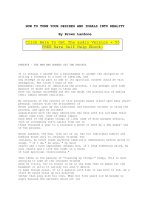How to reduce radiation dose and decrease contrast induced nephropathy
Bạn đang xem bản rút gọn của tài liệu. Xem và tải ngay bản đầy đủ của tài liệu tại đây (2.29 MB, 31 trang )
How to Reduce Radiation Dose and
Decrease Contrast-Induced Nephropathy
in the Cardiac Catheterization Laboratory
Vietnam National Congress of Cardiology
October 12, 2014
SCAI Fellow’s Course
Charles E. Chambers, MD, FSCAI, FACC, NCRP
President, Society for Cardiovascular Angiography and Interventions
Professor of Medicine and Radiology
Pennsylvania State University College of Medicine
Director, Cardiac Catheterization Laboratories
MS Hershey Medical Center, Hershey, PA
Society for Cardiovascular
Angiography and Intervention
Mission Statement
SCAI promotes excellence in
invasive and interventional
cardiovascular medicine
through physician
education and
representation, and the
advancement of quality
standards to enhance
patient care.
X-ray Image Formation
• Ideal X-ray Image
– Optimal X-ray imaging requires a kVp (peak tube voltage) and mA
(cathode current) that produces the best balance of image contrast, and
patient dose. Automatic dose rate controls increase x-ray tube output
for a specific size and projections for adequate detector entrance dose
rate and image quality.
• X-ray Dose
– “Dose” a measure of energy absorbed by tissue.
– The pt dose is derived from the X-ray photons
that enter but do not leave.
• Scattered Radiation
– Principal source of exposure to the
patient and staff.
Patient Dose
Assessment
• Fluoroscopic Time least useful.
• Total Air Kerma at the Interventional
Reference Point (Ka,r , Gy) is the x-ray
energy delivered to air 15cm from for
patient dose burden for deterministic skin
effects.
• Air Kerma Area Product (PKA , Gycm2) is
the product of air kerma and x-ray field
area. PKA estimates potential stochastic
effects (radiation induced cancer).
• Peak Skin Dose (PSD, Gy) is the maximum
dose received by any local area of patient
skin. No current method to measure PSD,
it can be estimated if air kerma and x-ray
geometry details are known. Joint
Commission Sentinel event, >15 Gy.
Total Air Kerma at the
Interventional Reference Point
• a/k/a Reference Air Kerma,
Cumulative Dose
• Measured at the IRP, may
be inside, outside, or on
surface of patient
• Iso-center is the point in
space through which the
central ray of the radiation
beam intersects with the
rotation axis of the gantry.
Patient
Isocenter
15 cm
Interventional
Reference
Point
(fixed to the
system gantry
Focal
Spot
Air Kerma-Area Product (PKA)
• Also abbreviated as KAP, DAP
• Dose x area of irradiated field (Gy·cm2)
• Total energy delivered to patient:
– Good indicator of stochastic risk
– Poor descriptor of skin dose
=
Biologic Effects of Radiation
• Deterministic injuries
– When large numbers of cells are damaged and die
immediately or shortly after irradiation. Units of Gy.
– There is a threshold dose for visible post procedure
injury ranging from erythema to skin necrosis.
• Stochastic injuries
– Post radiation damage, cell descendants are
clinically important. Higher dose, the more likely the
process.
– There is a linear non-threshold dose identifiable for
radiation-induced neoplasm and heritable genetic
defects. This is in units of Sv.
Radiation Dose
Management
• Justification of Exposure- benefit
must offset risk
• ALARA-As Low As Reasonably
Achievable
• Training
• Optimizing Patient Dose- From
Onset Of Procedure
• Radiation Safety Program- Every
Lab as Part of QA
Wilhelm Roentgen
Radiation Dose Reduction
Implementing a Culture & Philosophy
of Radiation Safety resulted in a
40% reduction in Cumulative Skin
Dose over a 3 yr period
Radiation Dose
Management in PCI
1. Pre-Procedure
•
•
•
•
•
•
Radiation safety program for cath lab
Dosimeter use, shielding,
training/education
Equipment and operator knowledge
On screen dose assessment (Ka,r , PKA)
Dose saving: store fluoro, adj. pulse
and frame rate, and last image hold
Pre-procedure dose planning
–
–
•
assess patient and procedure including
patient’s size and lesion(s) complexity
Informed patient with appropriate
consent
2. Procedure
•
•
•
•
•
•
•
•
•
Limit fluoro: use petal only when looking at screen
Limit cine: store fluoro if image quality not key
Limit magnification, frame rate, and steep angles
Use collimation and filters to fullest extent possible
Vary tube angle if possible to change skin exposed
Position table & image receptor: x-ray tube close to
pt increases dose; high image receptor incr. scatter
Keep pt & operator body parts out of field of view
Maximize shielding and distance from x-ray source
for all personnel
Manage and monitor dose in real time from the
beginning of the case
3. Post Procedure
Documentation of Dose
Follow-up Protocols
•Chambers CE. Radiation Dose in PCI. OUCH…Did
that hurt?
•JACC Cardiovasc Interv 2011.March Vol 4 (3); 344-6.
Procedure Related Issues to Minimize Exposure
to Patient and Operator
• Utilize radiation only when
imaging is necessary
• Minimize use of cine
• Minimize steep angle X-ray
beam
• Minimize use of magnification
modes
• Minimize frame rate of
fluoroscopy and cine
• Keep the image receptor close
to the patient
• Utilize collimation to the fullest
extent possible
• Monitor real time radiation dose
DRAPED:
• D-distance: inverse square law
• R-receptor: keep image receptor
close to patient and collimate
• A-angles: avoid steep angles
• P-pedal: keep foot off pedal
except when looking at the
monitor
• E: extremities-keep
patient/operator extremities out
of the beam
• D-dose: limit cine, adjust frame
rate, where personal dosimeter
Inverse Square Law
This relationship shows that doubling the
distance from a radiation source will
decrease the exposure rate to 1/4 the
original.
Higher head and eye exposure occurs during oblique angle projections Radiation
exposure decreases when the tube is tilted away (II toward).
Staff Radiation Protection
• Shielding
– Lead>90%; Proper care of aprons
– Thyroid shielding; most important <40
– Glasses-0.25 mm; must fit
– Portable: above/below table shielding
– Drapes (Bismuth-barium)
• Personnel Dosimeters: Your Protection
• Number and location
– ICRP recommends 2- Outside collar,
inside waist
– Single badge at Waist-Not acceptable
– Ring badge-Key if “need” hand in field
Take Proper Care
of Your Apron
Recommendations for Occupational Radiation
Protection in Interventional Cardiology, 2013
Updated Recommendations
• New Emphasis on Eye Protection
• ICRP Occupational Dose Limits
– Effective dose is now 20 mSv/yr
averaged over 5 consecutive yrs with
no one single year to exceed 50mSv
– Equivalent Dose ( 1 rem =10mSv)
• Eye-20 mSv
• Skin /Extremities-500 mSv/yr
• Two personal dosimeters
– However, one worn correctly
better than 2 worn improperly.
Endorsed by APSIC, EAPCI,
SOLACI, and SCAI
PostProcedure
Issues
• Cardiac Catheterization Reports should include Fluoroscopic Time, and Total
Air Kerma at the Interventional Reference Point (IRP) Cumulative Air Kerma
(Ka,r,, Gy) , and/or Air Kerma Area Product (PKA ,Gycm2) .
• FT is the least useful, PKA multiples of 100 in Gy/cm2 of the Ka,r in Gy.
• Chart Documentation following the procedure for Ka,r doses >5 Gy.
• Follow up at 30 day is required for Ka,r of 5-10 Gy. Phone calls or visit.
• For Ka,r > 10 Gy, a qualified physicist should perform a detailed analysis.
• Contact risk management within 24 hrs for calculated PSD > 15 Gy.
• Adverse Tissue Effects is best assessed by history/exam. Biopsy only for
uncertain diagnosis as the wound from the biopsy may result in a secondary
injury potentially more severe than the radiation injury.
Radiographic Contrast Media
Classification is based upon the agent’s ability to dissociate (ionic)
or not dissociate (nonionic) into ionic particles
Ionic Monomer
Ionic Dimer
Nonionic Monomer
Nonionic Dimer
Contrast Injury to the Kidney
Contrast Induced
Nephropathy (CIN)
Acute Kidney Injury
AKIN /KDIGO Classification
• Definition: an increase in
• Stage 1
serum Cr from baseline of
– 1.5 to 1.9 fold increase in Cr
>25%, or absolute >0.25 or
– Absolute increase >0.3 mg/dl
0.5 mg/dl.
• Stage 2
• Baseline renal disease
– 2-2.9 fold increase in Cr
increases risk as assessed by
eGFR or CrCl; age, sex , and • Stage 3
obesity factors in estimating
– >3 fold increase in serum Cr
eGFR/CrCl.
– Absolute increase >4 mg/dl
• Renal dysfunction is
– Acute increase >0.5 mg/dl
identifiable by 48 hrs and
AKIN-Acute Kidney Injury Network
most often returns to
KDIGO-Kidney Disease: Improvement in Global Outcomes
baseline by 7-10 days.
Acute Kidney Injury from Contrast
Incidence/Predictors
NCDR Report
• 985,737 patients underwent
PCI at 1,253 sites from June
2009- June 2011with AKIN
criteria
• Overall Incidence 7.1% with:
– Stage 1-6.0%; stage 2-0.5%;
stage 3-0.3% ; dialysis 0.3%
• Predictors
–
–
–
–
STEMI
Cardiogenic shock
Pre-existent renal disease
Contrast volume
Outcomes (In-hospital)
• No AKI
– MI-2.1%
– Bleeding -1.4%
– Death-0.5%
• AKI
– MI-3.8%
– Bleeding -6.4%
– Death-9.6%
• Dialysis
– MI -7.9%
– Bleeding -15.8%
– Death-34.3%
Tsai et al. Contemporary Incidence, Predictors, and Outcomes
of AKI in pts undergoing PCI. JACC Interv. 2014 Vol7 #1; Pg 1-9.
Pre-procedural Clinical Risk Factors for
Contrast Induced Nephropathy
• Modifiable Risk Factors
– Contrast volume
– Hydration status
– Concomitant nephrotoxic
agents
– Recent contrast
administrations
• Non-modifiable Risk
Factors
– Diabetes/Chronic kidney
disease
– Shock/hypotension
– Advanced age (> 75 yrs)
– Advanced congestive
heart failure
Klein LW, Sheldon MA, Brinker J, Mixon TA, Skeldiong K, Strunk AO, Tommaso CL, Weiner B, Bailey SR, Uretsky B, Kern M, Laskey W
. The use of radiographic contrast media during PCI: A focused review. Cathet Cardiovasc Int 2009; 74: 728-46
Multi-factorial Predictors of CIN
Cardiac Complication in Patients with CIN Post
PCI
• Mayo Clinic Registry of 7,586 pts post PCI
• Patients with CIN had increased rates of:
– CABG
p=0.004
– Q-MI
p< 0.001
– CK Rise
p<0.001
– Low BP
p<0.001
– Shock
p<0.001
– Cardiac Arrest
p<0.001
Rihal CS. Circ. 2002; 105:2259-64.
Mortality with CIN
Reducing CIN Risk Not
Prevention
• Pre-Procedure
– Hydration
• Normal Saline preferred over
D5 ½ normal; IV not oral
• Sodium Bicarbonate, mixed
reviews
• Identify Risk
– Medications
– Low risk: eGFR > 60 ml/1.73 m2
• NSAID stop if possible
• N-acetylcysteine, mixed
reviews, no clear benefit
• Statins (+/_); theophyline (-)
• Optimize hydration status.
– High risk: eGFR <60 ml/1.73 m2 • Procedure
• Schedule outpatient for early arrival
and/or delay procedure time to allow
time to accomplish the hydration.
– Contrast to CrCl ratio
– Contrast
• Volume, repeat studies
• Type-non-ionic/isoosmolar
• Post Procedure
– Hydration: Normal Saline & PO
2011 PCI Guidelines
3.2 Contrast-Induced Acute Kidney Injury
Recommendations
Class I
1. Patients should be assessed for risk of contrast-induced AKI before PCI. (Level of
Evidence: C)
2. Patients undergoing cardiac catheterization with contrast media should receive
adequate preparatory hydration . (Level of Evidence: B)
3. In patients with chronic kidney disease (creatinine clearance <60cc/min), the volume of
contrast media should be minimized . (Level of Evidence: B)
Class III: No Benefit
1. Administration of N-acetyl-L-cysteine is not useful for the prevention of contrast-induced
AKI . (Level of Evidence: A )
Contrast Dose
• Maximal Allowable Contrast Dose (MACD)
– 5 cc contrast x body wgt (kg)/ baseline Cr
– Brown et al, Circ Interv, 2010.
• Volume to Creatinine Clearance Ratio
– Contrast volume/ CrCl
– Laskey, JACC 2007, unselected population, 3.7 ratio
– Gurm et al, JACC, 2011, <2 safe; >3 concern









